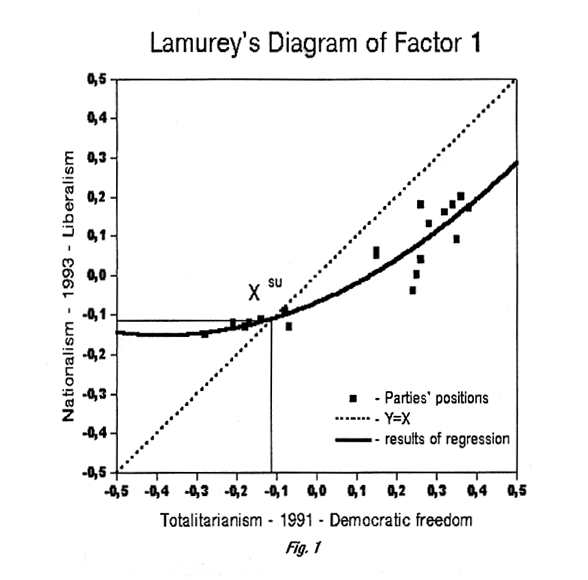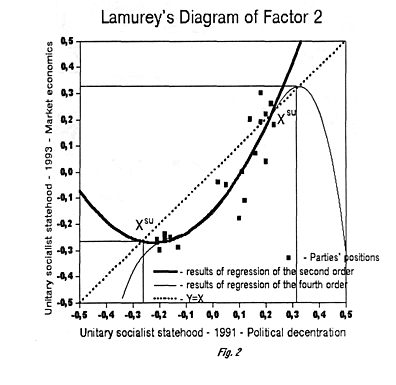

The methods of experimental psychosemantics allow the researcher to gain access to knowledge about how people think that is not always available to the subjects themselves. In psychosemantics, the task for the individual subject is to provide some classification
about a topic. The response could be a judgment of similarity, an indication of the extent to which she or he agrees or disagrees with a statement, or some other association. There are many different types of responses that are possible with this technique. On
the basis of numerous responses to a range of stimuli, a matrix of data is obtained from each subject. The matrix can then be used with any analytic technique that is based on matrix algebra. These include a variety of well-known multidimensional procedures such as factor analysis, cluster analysis, latent variable modeling, and many others. As a result, the researcher can find "bundles" of interconnected meaning that form the coordinate axes of semantic space. The number of independent factors that emerge from an analysis defines the number of dimensions that are used to locate meanings in semantic space. According to this geometric model of the mind, the greater the number of independent factors that emerge from an analysis, the greater the cognitive complexity of the individual, group or social consciousness.
Another parameter of semantic space, in addition to the number of factors or dimensions, is the importance of the factor. Some factors are stronger determinants of how people think than others. (Mathematically, the power of a factor is the proportion of the variability in the responses that can be accounted for by the factor.)
The structures that are found in a data matrix are interpreted as the categorical structures of the subject's semantic space. (In our case semantic space of political parties). These structures are the frameworks or skeletons of the mind that are not always available for self-observation or introspection just as the rules of grammar that adults use so easily cannot always be articulated, but nevertheless guide the use of a language.
The method of experimental psychosemantics allows us to thus operationally define consciousness (individual and social) by operationalizing it, and to compare the results with those based on dynamical system models, including those from synergetics, chaos theory, and bifurcation theory. Dynamical chaos provides a good example. Numeral meanings of different parameters obtained by using the psychosemantic method can be used in the nonlinear difference equations of dynamical systems theory describing the process of the development and functioning of consciousness.
We conducted three experiments in which we assessed political thought. The first was conducted just prior to the political earthquake that shook the Soviet Union and the rest of the world in 1991. The second was just prior to the attempted coup in Moscow in 1993. The timing of both of these experiments may seem fortuitous to those outside of Russia, but there were ample signs of change within Russia, so the timing was not merely "lucky." Bifurcations are exteremely important in dynamical systems, and Russia has thus provided us a rare opportunity to surf the bifurcations of a major political system. The results provided us with maps of the political mindscape in those moments.
The respondents were 1358 leaders and activists selected from 20 political parties or groups that were active in Russian both in 1991 and 1993. We extracted six factors from the combined data set from 1991 and 1993. All parties on each of 6 allocated factors are characterized by two points, appropriate to positions of each party on many issues, evaluated on each factor for 1991 and 1993. Thus, we have the meanings of an empirical ensemble of 20 points at each of two moments time.
Let Y=F (X)
be a regression curve, constructed on the basis of the statistical analysis of empirical meanings, specifying a position of each party in two-dimensional space, and being the closest theoretical approximation of experimental data, from the point of view of statistical criteria. Stable points on the theoretical curve (attractors) are centers of attraction of various political positions. We were able to determined the presence, if any, of a single, stable fixed point attractor and its basin of attraction, thus making it possible to speak about the allocation of an area of a consensus, smoothing out some of the contradictions. It is possible to speculate, that if there were parties (or political leaders), whose positions coincided with this stable stationary point, that they could become center of consolidation of forces of public opinion on a given issue of the election.
The third stage of the research in 1995 was conducted to determine positions of famous political leaders who participated in the 1996 presidential election. The positions were determined on the issues of two of the most important (of the 6) factors.
The positions of the parties are represented in the 2D space. The value for each party for a given factor in 1991 is represented on the X axis, and the value of that factor for 1993 is represented on the Y axis. For each factor there is a set of 20 points, one for each party. A regression curve was fit to these points for each factor.
The bisectrix, or 45° line (dotted line), represents the locus of points of no change from 1991 to 1993. Therefore, points, laying near the crossing of the regression line (solid line) with this bisectrix are stationary positions or stable fixed point attractors. The probability of change through this interval of time appears to be very small for those parties.
All semantic factors had some change, but because of close conceptions of some of these factors in 1991 and 1993 to each other in the Russian mentality, for the purposes of our model, we suggest their identity.
EXPERIMENTAL METHOD & RESULTS
 |
| Figure 1. There is a single point of stable stationarity (fixed point attractor) which is at Y=X=-0.11. |
 |
| Figure 2. There are two points of stable stationarity at Y=X=-0.26 and Y=X=0.31 |
In a third stage of research, positions on these factors for some of the 1996 presidential candidates were determined. Their positions represent subjective social opinion about these leaders. Results of this third stage of research and theoretical predictions according to our dynamical model shows that Yeltsin and Zuganov were both situated on factor 1 close to the fixed point -0.11 and also had a polar position on the factor 2 (Yeltsin had an image as a supporter of a free market economy and Zuganov had an image of unitary social statehood). They thus had the best chances to win in the election. The results of the elections confirmed this prognosis: both of them made it into the second round.
